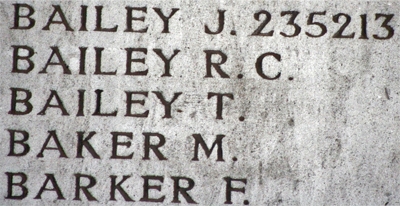1885 - 1916

CPL David Wallace Crawford
1887 - 1916

Lce-Corpl John Joseph Nickle
1894 - 1916

Pte 17911 Morton Neill
1897 - 1916

Lieut Edward Stanley Ashcroft
1883 - 1918

Pte 57940 Frank Alfred Barker

- Age: 20
- From: East Barnet
- Regiment: The King's (Liverpool Regiment) 18th Btn
- K.I.A Tuesday 31st July 1917
- Commemorated at: Menin Gate Memorial
Panel Ref: Panel 4 & 6
Frank enlisted in Fulham and originally served as Private 502, in the London Divisional Cyclist Company. Following a transfer he was serving in the 18th Battalion, The King’s Liverpool Regiment as Private No 57940 aged 20 when he was killed in action on the 31st July 1917 during the Third Battle of Ypres.
18th Battalion
On this day, before Zero Hour, the 18th Battalion was part of 21st Brigade and was to form up for the attack from trenches from the area of Sanctuary Wood to Observatory Ridge but it was dark and continually falling rain gave very poor visibility. The departure of the 21st Brigade was delayed by heavy shelling.
The 18th King’s began to move forward in the rear of the 2nd Battalion of the Wiltshire Regiment who had been detailed as the left attacking battalion of the 21st Brigade.
No’s 1 and 3 Companies of the King’s led the way followed by No’s 2 and 4. In Sanctuary Wood there was considerable confusion, as a result No.2 and No.4 Companies became separated from the others, and were moved over to the left flank towards positions known as Surbiton Villas and Clapham Junction in the direction of the 90th Brigade.
No.1 and 3 Companies were soon in action with the enemy, and were for a time, held up against an enemy strong point. They pushed forward with their right on a trench known as Jar Row and their left on the tramway south of Stirling Castle. Advance along Jar Row was held up by the Germans who put up a fierce resistance and the party was forced to withdraw.
Another group of men from No.1 and No.3 Companies led by 2nd Lieutenant Graham were being held up by another strongpoint which was south of Stirling Castle, which was eventually stormed and taken. Not far away from this action, an attempt, by other men of No.1 and No.3 companies, was made to penetrate a broad belt of uncut wire, but this was covered by Machine-guns which killed almost every man attempting to pass through the two gaps that were discovered.
The situation was similar with No.2 and 4 Companies, who had attacked along the wrong axis. Their advance was met with fierce opposition, and once all the experienced officer’s had been killed or wounded, all cohesion was lost, although some men did reach and cross the Menin Road at Clapham Junction.
By that time, the situation had become extremely confused, and the whereabouts of all four companies being unknown to Battalion Headquarters, urgent attempts were made to discover their locations. Eventually by mid- afternoon, it was established that the bulk of the companies, although all mixed together, were dug in the vicinity of Stirling Castle and by mid evening, the Battalion Headquarters moved forward to meet them.
During its time in the line the 18th Battalion lost 7 officers and 76 men killed or died of wounds and 7 officers and 177 men wounded. They were relieved on the 2nd August.
"18th King's HQ was at Crab Crawl Tunnel ...zero hour was 3:50 a.m.
He was reported missing in the Weekly Casualty List of 18th September 1917:
The site of the Menin Gate was chosen because of the hundreds of thousands of men who passed through it on their way to the battlefields. It commemorates casualties from the forces of Australia, Canada, India, South Africa and United Kingdom who died in the Salient. In the case of United Kingdom casualties, only those prior 16 August 1917 (with some exceptions). United Kingdom and New Zealand servicemen who died after that date are named on the memorial at Tyne Cot, a site which marks the furthest point reached by Commonwealth forces in Belgium until nearly the end of the war. New Zealand casualties that died prior to 16 August 1917 are commemorated on memorials at Buttes New British Cemetery and Messines Ridge British Cemetery.
The YPRES (MENIN GATE) MEMORIAL now bears the names of more than 54,000 officers and men whose graves are not known. The memorial, designed by Sir Reginald Blomfield with sculpture by Sir William Reid-Dick, was unveiled by Lord Plumer on 24 July 1927.
Parents appear on the 1939 register at 77, East Barnet Rd., New Barnet, Herts. Father Alfred, dob 05th August 1870 and a dairyman, mother Annie E., dob 18th June 1867.
His mother died aged 77 in the June quarter of 1945, her death registered in Biggleswade.
His father died aged 77 in the March quarter of 1947, his death registered in Barnet.
We currently have no further information on Frank Alfred Barker, If you have or know someone who may be able to add to the history of this soldier, please contact us.
Killed On This Day.
(109 Years this day)Saturday 28th October 1916.
2nd Lieutenant Ernest Bailey
24 years old
(109 Years this day)
Saturday 28th October 1916.
2nd Lieutenant Stafford Thomas Eaton-Jones
20 years old
(109 Years this day)
Saturday 28th October 1916.
2nd Lieutenant Ronald Hamilton William Murdoch
21 years old
(109 Years this day)
Saturday 28th October 1916.
2nd Lieutenant James Stewart
39 years old
(108 Years this day)
Sunday 28th October 1917.
Serjeant 38645 John McGlashan
32 years old
(107 Years this day)
Monday 28th October 1918.
Pte 12056 Sandford Woods
30 years old
(107 Years this day)
Monday 28th October 1918.
Rifleman 22814 Charles Reginald Pollington
30 years old
